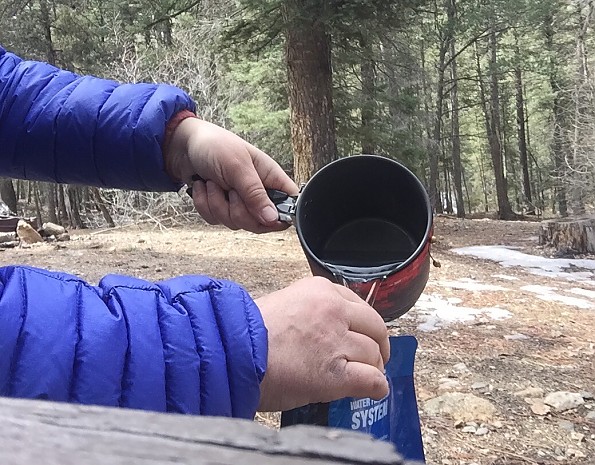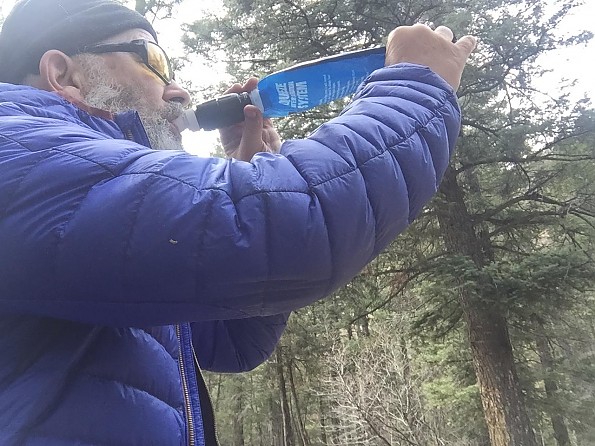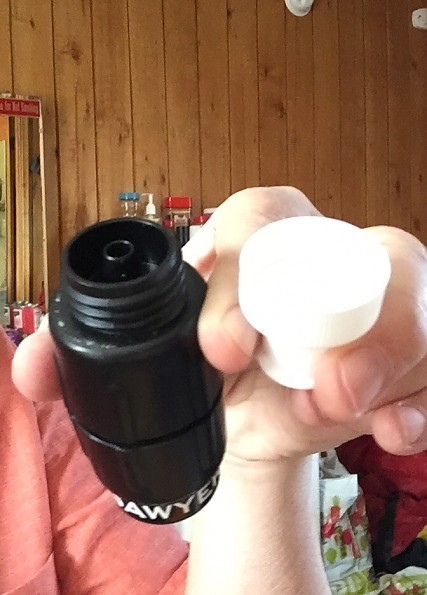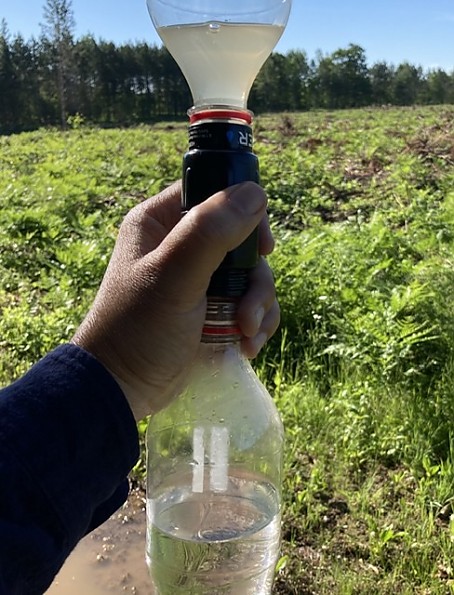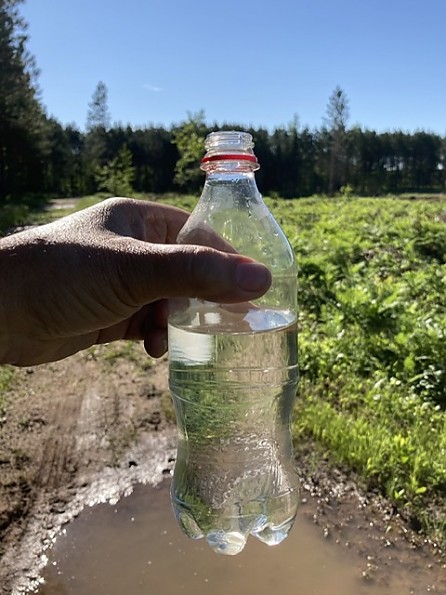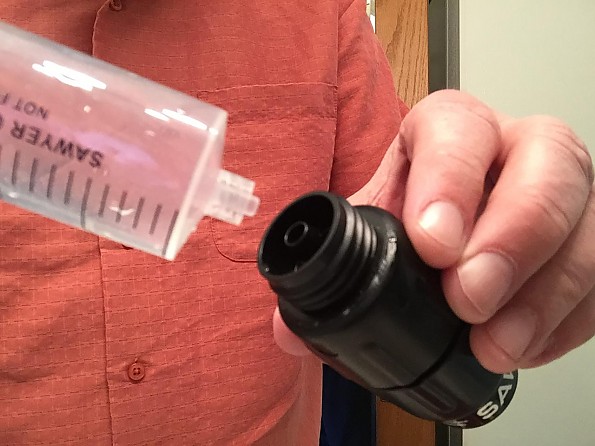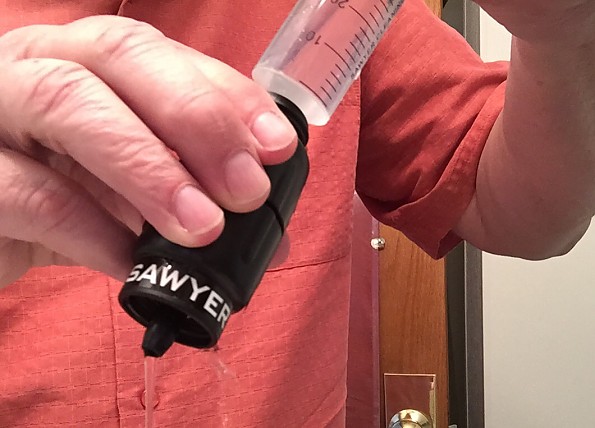Sawyer Micro Squeeze

The Sawyer Micro Squeeze is a very lightweight, compact, and versatile water filtration system with a long lifespan that will help keep you safely hydrated on the trail. You can drink directly from the water source with the included straw or filter water from the included bladder using the squeeze method or from disposable water or soda bottles using the gravity method. Once filtered it's ready to drink or store in the vessel of your choice, and you can even direct line to hydration packs.
Pros
- Lightweight
- High capacity filter (up to 100,000 gallons!)
- Filter membrane never needs replacement
- Very compact
- .1 micron filtration Filters out 99.9999% of Bacteria, Protozoa, and Cysts, including E. Coli, giardia, vibrio cholerea, Salmonella typhi, and microplastics
- Includes 32-oz bladder with instructions printed on it
Cons
- I would like to see an arrow printed on the filter that indicates flow direction
- The plunger on the drinking fitting requires an extremely high effort to open up at first.
- Instructions on packaging could be more thorough
Sawyer filters are highly regarded in the thru-hiking community, so I was anxious to put the Micro Squeeze to the test during my backpacking trip in Utah, and my upcoming bicycle tour of the USA.
Packaging:
 I immediately read and noted the capabilities of the Sawyer Micro Squeeze printed on the package. There is a warning on the package which states that "Boil Alerts" when issued need to be adhered to in order to eliminate harmful pathogens. The Micro Squeeze WILL NOT filter out viruses.
I immediately read and noted the capabilities of the Sawyer Micro Squeeze printed on the package. There is a warning on the package which states that "Boil Alerts" when issued need to be adhered to in order to eliminate harmful pathogens. The Micro Squeeze WILL NOT filter out viruses.
The Micro Squeeze Filter element is .1 micron and filters out 99.9999% of bacteria (salmonella, cholera and E. coli), 99.9999% of protozoa (cryptosporidium and giardia), and 100% of microsplastics—exceeding EPA recommendations for removal rates.
The filter treats up to 100,000 gallons! I had to immediately wonder how this figure was arrived at? At 2 gallons per day for regular consumption, this filter could conceivably last 50,000 days? That’s 137 years. My great-great-great grandchildren won’t wear this thing out! The package also states that the units get tested three times, for which I’m grateful.
Package Contents: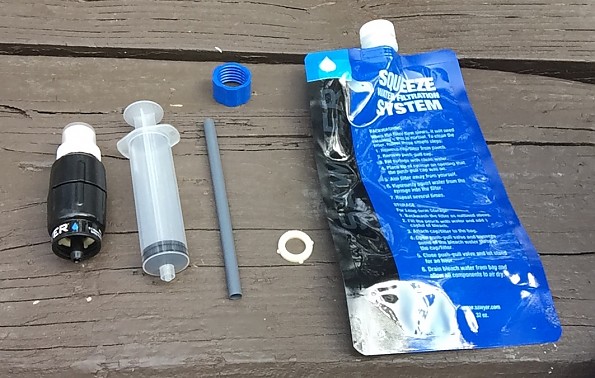 The kit contains (left to right) the filter membrane module (note the printing on the female end), backflushing syringe, straw, threaded connecting coupling for cleaning, a spare nylon washer and one collapsible 32-oz bladder with printed instructions.
The kit contains (left to right) the filter membrane module (note the printing on the female end), backflushing syringe, straw, threaded connecting coupling for cleaning, a spare nylon washer and one collapsible 32-oz bladder with printed instructions.
Weight:
According to the packaging, the Sawyer Micro Squeeze weighs 2 ounces dry. Bear in mind that the filter will continue to hold water after use and this 2 ounces becomes heavier after the first go, as residual moisture remains in the filter membrane. Granted, it is still very light and a wonderfully thought out piece of kit considering its inherent value on the trail.
Size:
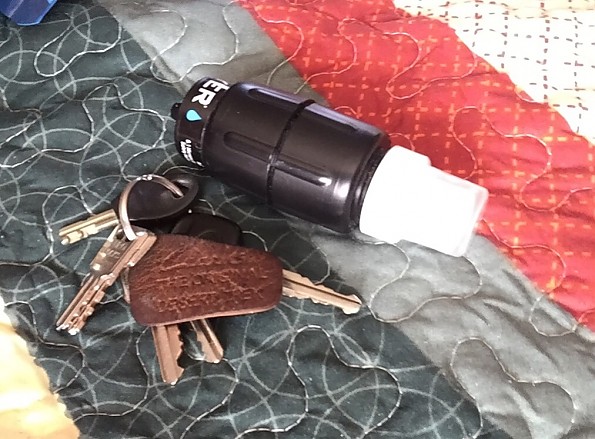 Did I mention that it is small? Here is the filter membrane module next to my car keys for scale.
Did I mention that it is small? Here is the filter membrane module next to my car keys for scale.
How it works:
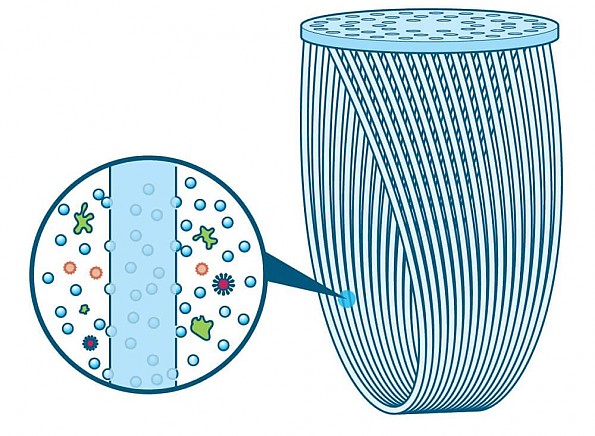
(From Sawyer's website) The tiny hollow 'U' shaped membrane fibers trap contaminants while allowing clean water to flow freely around them.
The first thing I noted was that there isn’t an arrow printed on the filter module that indicates direction of flow. Presumably, anyone can figure this out on their own given the unfiltered water connection is a female fitting, and the filtered water output connector is a male fitting.
There will be some who’ll stare at it with a screwed up expression on their faces wondering which end goes where. You could conceivably put the straw on the output end and place that end into raw water and suck through it backwards I guess. Anyway, I’ve seen filters that have this arrow printed on the module. It helps to be as thorough as possible.
In Use: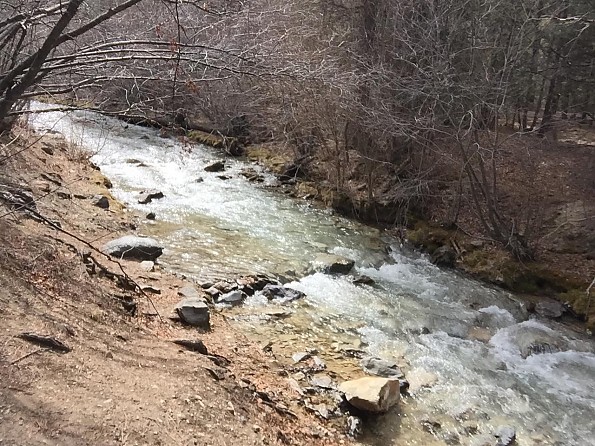 First I need to locate a water source, in this case, a mountain stream in New Mexico.
First I need to locate a water source, in this case, a mountain stream in New Mexico.
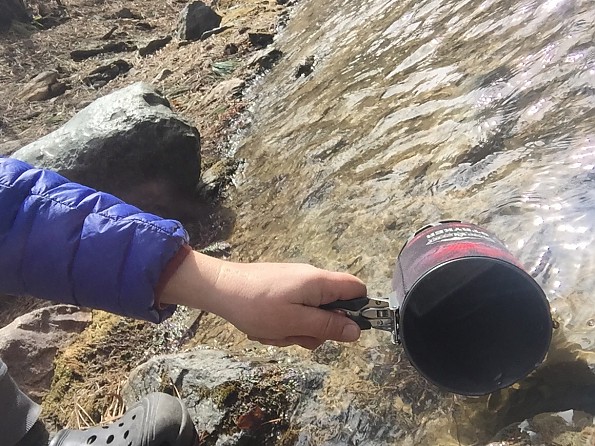 Then I fill up a container with the raw water and take it back to camp.
Then I fill up a container with the raw water and take it back to camp.
What I do as a way to keep things clear, is first fill the included printed bladder with unfiltered water (and only put unfiltered raw water in this bag), and connect the filter module to the bag so that the printing on the female end is right side up.
The output nozzle is on the male end and it is a recognizable plunger fitting for drinking. It is now ready to drink directly from that nozzle. (It bears noting here, that I found that plunger fitting to be really high effort to open. I had to use my teeth. Not a pleasant experience.) Or, you could filter water without attaching the bag by attaching the straw to the female end of the module and insert the other end of the straw directly into the water source or from a different container with the male end drinking plunger thingy at your mouth.
Or you could unscrew the drinking plunger fitting...
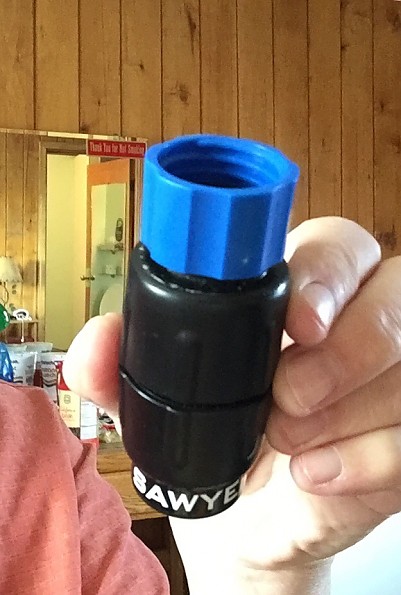 ...and attach the included threaded cleaning coupling to the male end...
...and attach the included threaded cleaning coupling to the male end...
...and attach another water bag to it and filter the water directly into that bag. I tried this with the extra nylon washer in the fitting and vapor lock ensued, which required me to unscrew the nozzle partway until I heard it go “pffft” and then rescrewed it only to need to repeat the process several times. Without the washer it works just fine. Yeah, don’t use the washer! There was nothing in the instructions about using this method. Or, one could just filter the water into a different container like a gallon jug and fill your water bottles from it.
At a small creek in Michigan's Upper Peninsula, I was curious to see if the Micro Squeeze would filter out some of the tannic acid that's so prevalent in northern deciduous forests. The water source is a small creek that empties into a swampy shallow lake.
Yeah, coffee colored water!
Before filtering the water, I passed it through my bandana to eliminate the larger flotsam bits in the water.
The image on the left is before filtration, and the one on the right is after.
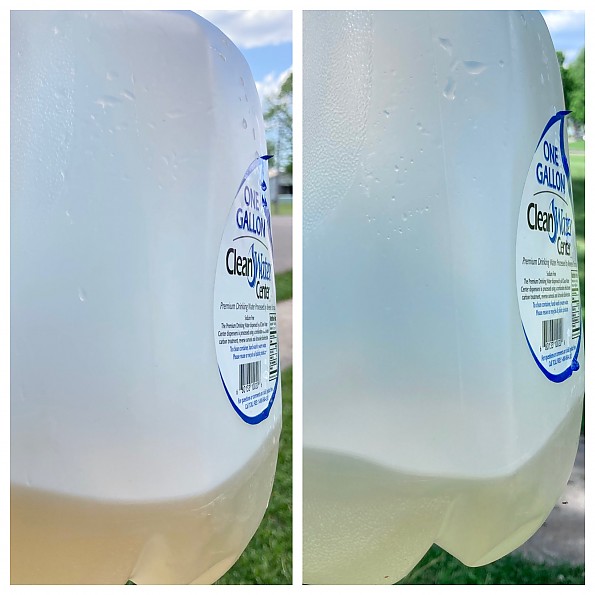 There is a slight improvement in the water color afterward. And it was delicious as well!
There is a slight improvement in the water color afterward. And it was delicious as well!
How would this filter manage puddle water on a logging road? 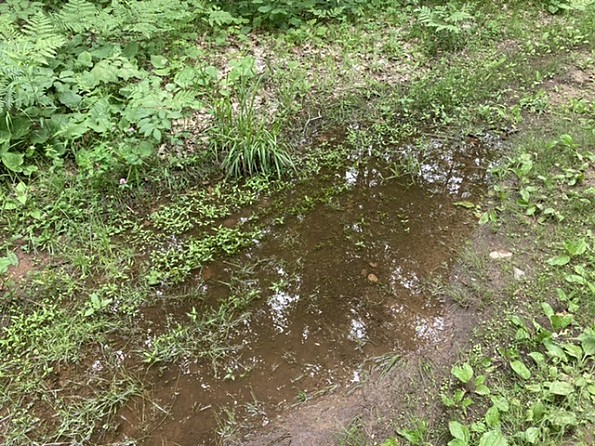
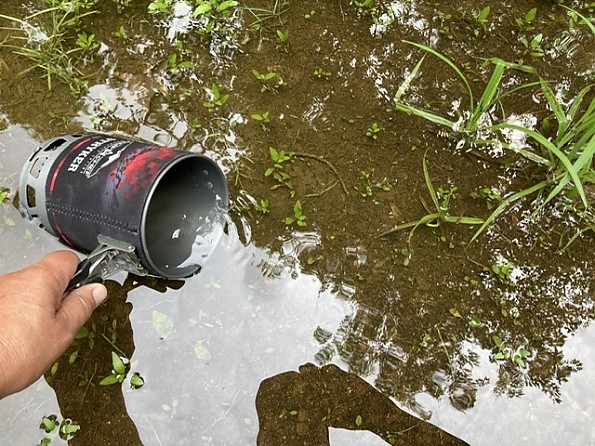
 Very well, thank you!
Very well, thank you!
Here's a puddle that is quite murky. Let's see what the Micro Squeeze can do with it!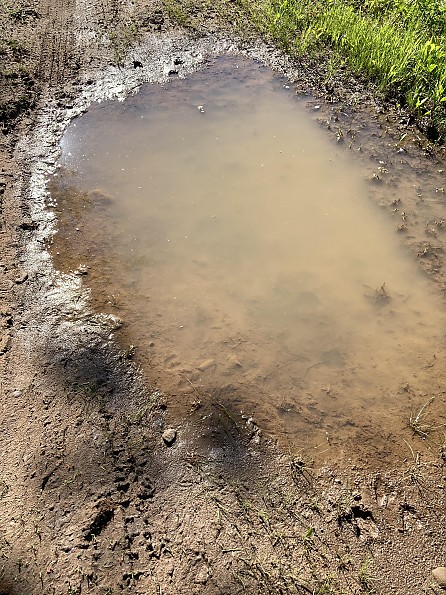
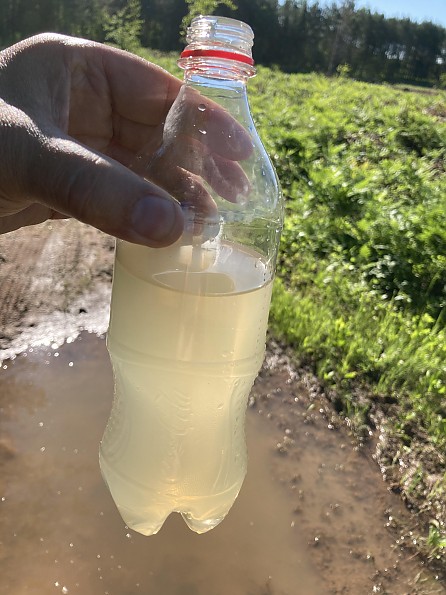 Here, I've repurposed a couple of empty soda bottles.
Here, I've repurposed a couple of empty soda bottles.
As you can see, the Sawyer Micro Squeeze cleans up the dirty water beautifully. I felt the need to back flush after this experiment. (See Maintenance below.)
I also wanted to know how the flow rate would be just using gravity without applying and pressure to the bladder. If one needs to filter a lot of water, you could find yourself with a sore arm from holding the bladder and filter apparatus for very long.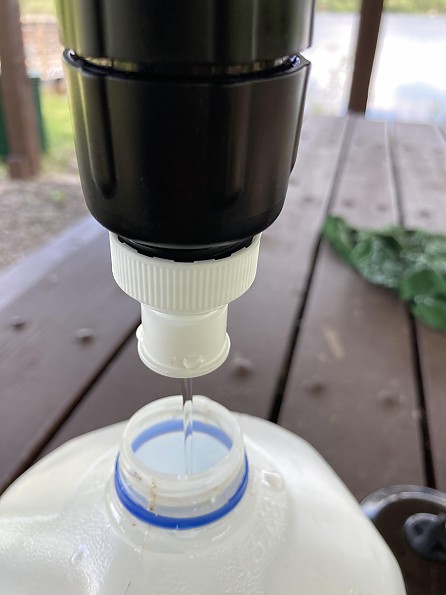 As you can see, the flow is pretty meager. Thankfully, the filter fits most water bottles, so I tried using the gravity method with an empty 2-liter soda bottle. The filter threaded onto the bottle perfectly.
As you can see, the flow is pretty meager. Thankfully, the filter fits most water bottles, so I tried using the gravity method with an empty 2-liter soda bottle. The filter threaded onto the bottle perfectly.
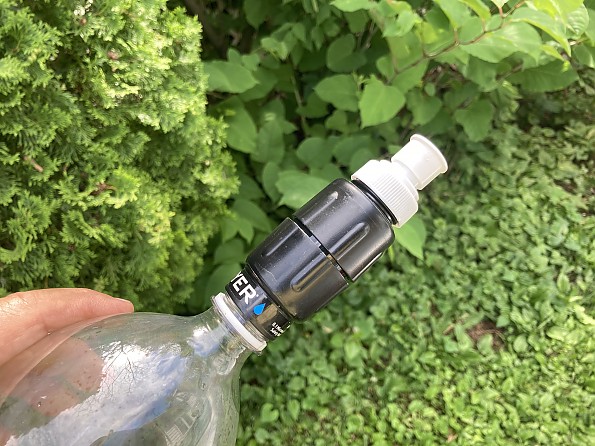
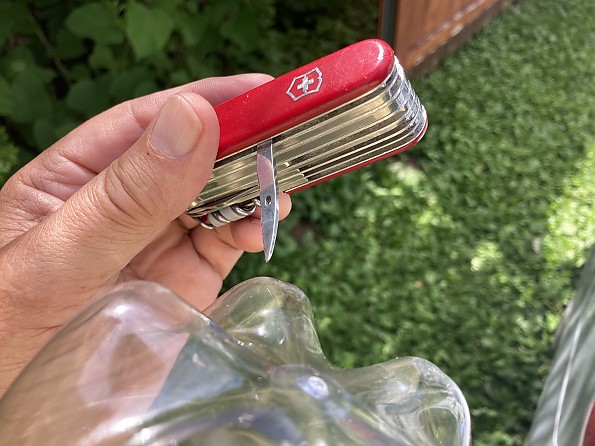 Then I poked a vent hole into the bottom of the bottle and plugged it with my finger while I filled it with raw water.
Then I poked a vent hole into the bottom of the bottle and plugged it with my finger while I filled it with raw water.
 I was curious as to how long it would take 2 liters of water to filter unattended using this gravity method so I timed it.
I was curious as to how long it would take 2 liters of water to filter unattended using this gravity method so I timed it.
 So, you could be preparing for a meal or taking a rest break while your water filters unattended. Granted, 19 minutes is a longish time, but it frees you up to do other things. You could conceivably expedite the gravity filtration method by removing the bottom of the raw water bottle entirely and keeping it topped off to increase the weight of the water column, thus increasing the flow rate.
So, you could be preparing for a meal or taking a rest break while your water filters unattended. Granted, 19 minutes is a longish time, but it frees you up to do other things. You could conceivably expedite the gravity filtration method by removing the bottom of the raw water bottle entirely and keeping it topped off to increase the weight of the water column, thus increasing the flow rate.
Or you could elevate the bottle and use an extension hose from bottle to filter, thus increasing the height of the water column and expediting the filtration. The gravity method would also serve to extend the usable life of the bladder included with the kit.
Maintenance:
Back flushing is a very simple, easy, and straightforward exercise. The filter membrane module needs back flushing when it becomes difficult to filter water through it using normal pressure. Remove the drinking mouthpiece from the male end. Fill the syringe with fresh water and insert it into the narrow opening at the male end and squirt the water backwards through the membrane module. Repeat. I've found it helpful to give the membrane module a few good downward shakes to expel excess moisture from inside.
Now it’s cleared out and ready for service again.
It bears noting that the tip of the syringe has interior threads but the corresponding narrow opening at the male end of the module does not. I’ve tried to screw it on to no avail. It can get messy If you’re not careful to apply sufficient pressure on the apparatus.
Storage:
The instructions also state that if you plan to store it, to backflush using a chlorine bleach/water solution and also use this solution in the water bag to prevent mildew. (Ah, this is why my other water bags smell like old leather boots.) A capful of bleach in one liter of water mixed directly in the Micro Squeeze bladder. Then I pass it through the filter membrane module and back flush with the same solution. On their website, Sawyer warns against using overly strong bleach solutions.
Keep the Filter From Freezing!
It must be mentioned that care should be taken to prevent the filter membrane from freezing. A frozen membrane will not filter water and could also damage the membrane due to expansion. A good practice here is to keep the filter module in a base layer pocket during freezing temperatures and inside your sleeping bag at night.
Final thoughts:
So far, this Sawyer Micro Squeeze has shown to be a seriously versatile contender in an amazingly small package:
- Filters out 99.9999% of Bacteria, Protozoa, and Cysts, including E. Coli, giardia, vibrio cholerea, Salmonella typhi, and microplastics
- BEST USES: Hiking, backpacking, ultralight backpacking, camping and emergency preparedness (from Sawyer's website)—and bicycle touring!
- Treats up to 100,000 gallons
- Filter element never needs replacing
- Drink directly from the water source
- Drink from the bladder
- Filter water into another container for later use
- Utilize the squeeze method or gravity filtration
- Attach in line on hydration packs
I will update this review at a later date during my long bicycle tour to report on its durability after continued use in a wide variety of water sources. It would please me greatly to curtail packing the 7 liters of water on my bicycle that I normally carry.
Background
For the purpose of this initial review, I've taken water from a fast moving mountain stream in the Sangre de Cristo mountains in New Mexico, from a slow moving creek near Iron Mountain in Michigan's Upper Peninsula, and from two different puddles on a logging road in the Chequamegon-Nicolet National Forest in Northern Wisconsin.
In the past, I've boiled water or have lugged water from municipal sources.
Source: received for testing via the Trailspace Review Corps
(Sample for testing and review provided by Sawyer)
Your Review
Where to Buy
You May Like
Specs
| Price |
MSRP: $28.99 Current Retail: $28.95-$33.99 Historic Range: $22.36-$33.99 |
| Weight |
2 oz |
| Longevity |
up to 100,000 gallons |
| Volume |
includes 32-oz pouch |
| Filter Material |
Hollow fiber membrane |
| Removes |
Bacteria, Protozoa, and Cysts, including E. Coli, giardia, vibrio cholerea, Salmonella typhi, and microplastics |
| Best Uses |
Hiking, backpacking, ultralight backpacking, camping, emergency preparedness |



